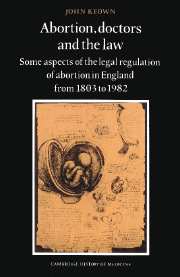 Abortion, Doctors and the Law
Abortion, Doctors and the Law Published online by Cambridge University Press: 26 October 2009
In Chapters 1 and 2 it was suggested that the passage and shape of the anti-abortion enactments from 1803 to 1861 were influenced by regular medical practitioners who relentlessly urged the need for suppression by the law of a practice which threatened not only fetal and maternal welfare but also the interests of their profession.
However, there is reason to approach the regulars' expressions of concern for fetal life with caution. Just as it would be simplistic to assume that their condemnation of abortion was purely altruistic, so too would it be superficial to conclude that they regarded fetal life as inviolable.
Medical abortion and the law 1803–1938
On 27 April 1938 a girl of fourteen was raped. She was taken to see Dr Joan Malleson, a member of the medico-legal council of the Abortion Law Reform Association, who contacted a fellow council member, Dr Aleck Bourne, obstetric surgeon to St Mary's Hospital. He replied:
I shall be delighted to take her in at St. Mary's and curette her. I have done that before and shall not have the slightest hesitation in doing it again. I have said that the next time I have the opportunity I will write to the Attorney-General and invite him to take action.
On 31 May, the girl was taken to see Dr Bourne by her mother. A letter of consent to the proposed operation was then obtained from her father. Bourne then saw Dr Wingate, a resident obstetric officer at St Mary's and informed him of his reasons for operating, namely that the girl was under the age of consent and had been raped. On 6 June she was admitted to the hospital. A pregnancy test proved positive.
To save this book to your Kindle, first ensure [email protected] is added to your Approved Personal Document E-mail List under your Personal Document Settings on the Manage Your Content and Devices page of your Amazon account. Then enter the ‘name’ part of your Kindle email address below. Find out more about saving to your Kindle.
Note you can select to save to either the @free.kindle.com or @kindle.com variations. ‘@free.kindle.com’ emails are free but can only be saved to your device when it is connected to wi-fi. ‘@kindle.com’ emails can be delivered even when you are not connected to wi-fi, but note that service fees apply.
Find out more about the Kindle Personal Document Service.
To save content items to your account, please confirm that you agree to abide by our usage policies. If this is the first time you use this feature, you will be asked to authorise Cambridge Core to connect with your account. Find out more about saving content to Dropbox.
To save content items to your account, please confirm that you agree to abide by our usage policies. If this is the first time you use this feature, you will be asked to authorise Cambridge Core to connect with your account. Find out more about saving content to Google Drive.